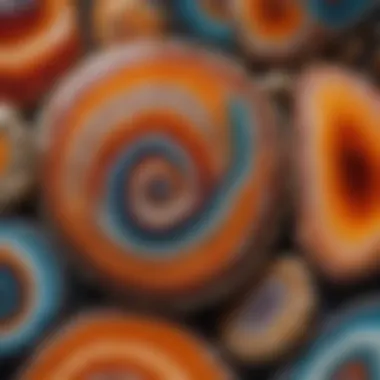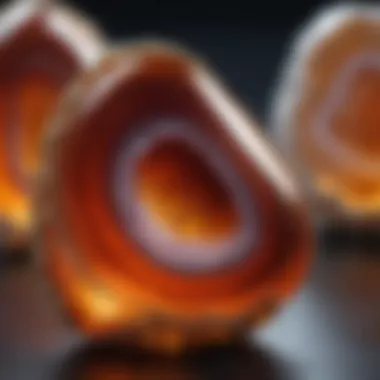Understanding Agate Buyers: Insights and Considerations


Intro
In the realm of gemstones, agate stands out for its unique patterns and formations. As a potential buyer or an enthusiast, it's important to grasp the motivations and preferences that drive agate purchases. This guide will navigate you through various aspects of agate buyers, enabling a better understanding of the market dynamics and the considerations involved in making a purchase.
Gemstone Overview
Definition and characteristics
Agate is a form of silica, primarily composed of quartz. It is characterized by its fine-grained texture and often banded appearance. The colors and patterns vary depending on the geology from where it is sourced. Each agate piece tells a story, shaped by its formation over thousands of years. Buyers appreciate agate for both its aesthetic value and its metaphysical properties, believing it promotes stability and balance.
Classification of gemstones
Gemstones can be broadly classified into precious and semi-precious categories. Agate falls under the semi-precious category. This classification often depends on rarity, brilliance, and perceived value. However, many collectors consider quality to be subjective and may prioritize visual appeal over traditional categorization.
Properties of Gemstones
Physical properties
The physical properties of agate include its hardness, which ranks between 6.5 and 7 on the Mohs scale. This durability makes it suitable for various applications, from jewelry to ornamental objects. Additionally, agate is known for its translucence; light can pass through it, highlighting its intricate patterns. Buyers often seek these characteristics when selecting a piece that matches their personal style.
Chemical properties
Chemically, agate is primarily composed of Silicon Dioxide (SiO2). This makes it relatively stable and resistant to chemical weathering. Buyers should be aware of these properties, as they can affect the gemstone's longevity and suitability for everyday wear. A well-informed buyer will recognize the significance of quality assessment and ethical sourcing in determining both the value and the authenticity of agate.
"Understanding the dynamics of gemstone properties is crucial for making informed purchasing decisions."
Prelude to Agate
Understanding agate is essential for both casual buyers and serious collectors in the gem market. Agate can be appreciated for its beauty and uniqueness, but knowing the type and quality can influence one's purchasing decisions significantly. This section will provide an overview of agate's characteristics, historical context, and the array of varieties available.
By learning about agate, potential buyers can better appreciate the stone’s value and make well-informed choices. The importance of familiarity with agate cannot be overstated; it shapes how one understands sourcing, pricing, and ultimately, satisfaction with their purchases.
What is Agate?
Agate is a form of chalcedony, a mineral in the quartz family. This gemstone is characterized by its banded appearance, resulting from the layering of minerals and silica deposits. The unique combination of colors and patterns makes each piece of agate distinct.
Moreover, agate often displays a range of hues, from deep reds and blues to more subtle pastels. The stone is known for its durability and can be polished to a high shine, making it an attractive choice for jewelry and ornamental pieces. The hardness of agate contrasts with some other gemstones, allowing for versatile uses in various forms, including carvings and beads.
Historical Significance of Agate
Historically, agate has been the object of human fascination for thousands of years. In ancient times, it was used as a talisman believed to protect against misfortune or harm. Various cultures valued agate for its supposed healing properties, associating it with stability and grounding.
Archaeological findings reveal that agate was mined and traded by ancient civilizations like the Egyptians, Greeks, and Romans. Its significance is evident in artifacts, jewelry, and decorative items. Today, understanding this history adds depth to appreciating agate since its cultural implications enhance both its aesthetic and monetary value.
Varieties of Agate
There is a vast array of agate varieties, each offering distinct appearances and meanings. Some of the most popular include:
- Moss Agate: Distinguished by its green, moss-like patterns, this variety is often associated with nature.
- Botswana Agate: Known for its unique pink and gray banding, prized for its beauty and calming qualities.
- Blue Lace Agate: Light blue with delicate lace-like banding; valued for its serene associations.
- Fire Agate: This variant displays vivid colors and patterns that seem to shimmer, often likened to flames.


Each type of agate has its own specific attributes and possible uses, appealing to different buyer preferences.
"The unique patterns and colors of each agate type make every piece a work of art, reflecting both nature's artistry and the potential for personal expression."
Understanding the Agate Market
Understanding the agate market is essential for both potential buyers and existing collectors alike. This segment lays the groundwork for recognizing what drives the demand for agate stones, how market trends can affect availability, and the varying price points that can arise from these dynamics. With a clear grasp of these elements, buyers can make informed choices, maximizing their investments and satisfaction with their purchases.
Current Trends in Agate Buying
Current trends reveal a growing appreciation for agate among diverse groups. As the popularity of natural and organic materials increases, agate has found its place in jewelry, home décor, and even in spiritual practices. Many buyers are drawn to its unique appearance and historical significance. Moreover, social media influences buying habits. Platforms like Instagram showcase stunning agate pieces, encouraging impulse buys. The rise of online markets has also changed the game. More people are looking to e-commerce websites for their purchases, finding a wider selection than local shops can offer. This shift not only broadens access but also introduces competition that can lead to interesting pricing dynamics.
Top Locations for Agate Sourcing
Agate is sourced from various locations worldwide, each offering unique characteristics and colors. Some of the most noteworthy regions include Brazil, the United States, and Madagascar. Brazil is famous for its vibrant hues, often featuring excellent translucency. The state of Oregon in the US is renowned for its unique patterns and rich deposits. Madagascar also produces stunning specimens, often sought after for their rarity. Recognizing these sources allows buyers to align their purchasing decisions with the type of agate they seek—be it for collection, crafting, or decoration.
Price Fluctuations in the Agate Market
Price fluctuations in the agate market can result from various factors. Supply and demand play a significant role; when a certain type of agate gains popularity, its price can surge. Seasonal factors can also influence availability. For example, the impact of natural disasters or changes in mining practices can cause price variations. Furthermore, the condition and quality of each piece—such as its clarity and color—impact pricing. Keeping an eye on these fluctuations helps buyers make strategic decisions that can save money and enhance their collections.
"Understanding these dynamics is not just about buying stones; it's about investing wisely and appreciating the art within each piece."
Profile of the Typical Agate Buyer
Understanding the profile of the typical agate buyer is crucial for both sellers and market analysts. This section focuses on demographic insights, buyer motivations, and the roles that collectors and casual buyers play in the marketplace. By detailing these aspects, we gain insight not only into who buys agate but also why they invest in this particular gemstone. Recognizing these patterns will help stakeholders tailor their offerings and marketing strategies more effectively.
Demographics of Agate Buyers
Demographics offer important clues about the composition of the agate buying community. Typically, agate buyers span various age groups, although most enthusiasts are aged between 30 to 55 years. This age range often corresponds with a greater disposable income and a keen interest in different forms of collectibles.
Gender also plays a role, with an almost even distribution between male and female buyers. However, certain trends suggest that women are more prevalent in the jewelry sector, while men are more drawn to agate for its geological and collector value.
Additionally, many agate buyers hold educational backgrounds in geology, art, or related fields. This indicates a level of appreciation for the scientific and aesthetic qualities of the stone. Locations of buyers are diverse. Urban areas typically see more demand due to access to gem fairs, specialty shops, and online markets.
Buyer Motivations and Preferences
Understanding what drives agate purchases helps to paint a clearer picture of buyer profiles. Many individuals are primarily attracted to agate for its unique beauty and variations in color and texture. However, motivations often extend beyond mere aesthetics.
- Collector’s Passion: Some buyers view agate as an investment or part of a larger collection. This motivation is usually accompanied by extensive knowledge about the different types of agate and their origins.
- Jewelry Use: Others buy agate to create or wear jewelry. Such buyers often look for specific characteristics like color and clarity, prioritizing those that will complement their personal style.
- Healing Properties: A segment of buyers is also drawn to the purported healing properties of agate. They often seek out specific varieties believed to provide emotional or physical benefits.
The Role of Collectors vs. Casual Buyers
The agate market is shaped by two primary types of buyers: collectors and casual buyers.
- Collectors seek rare specimens and often build extensive collections over time. They usually prioritize quality over quantity and often have considerable knowledge about the stones they purchase. This group can have significant influence on market trends and pricing, as rare varieties may command high prices.
- Casual Buyers, on the other hand, may purchase agate more for decorative purposes or as gifts. Their focus tends to be on aesthetic appeal rather than investment. While not as knowledgeable as collectors, they are important to the market as they contribute to overall sales and may become more engaged as their interest grows.
Understanding the distinct motivations and roles of different types of agate buyers helps sellers tailor their strategies and better serve their clientele.
Factors Influencing Agate Purchases


Understanding the factors that influence agate purchases is crucial for buyers. Knowledge in this area can enhance decision-making and lead to more satisfying investments in their collections. Common influences include the quality of the stone, ethical sourcing, and the rarity of varieties available in the market.
Quality Assessment of Agate
A critical component in agate purchases is quality assessment. Buyers should learn how to evaluate the stones based on several prominent characteristics: color, clarity, cut, and carat weight.
Color
Color plays a significant role in the appeal of agate. The range of colors in agate is vast, from vibrant reds to deep blues and soft pastels. Each hue can evoke different feelings or fit various themes in jewelry and home decor. A bright or unique color can instantly elevate the value and desirability of the stone. For instance, a richly saturated red agate may be favored for its bold appearance and versatility. However, sometimes vibrant colors may come from treatments or enhancements, so it’s essential to verify their authenticity when buying.
Clarity
Clarity refers to the presence or absence of inclusions, blemishes, or other imperfections within the stone. High clarity often translates to higher value among collectors. An agate piece with minimal inclusions appears more visually striking and is preferred for fine jewelry. Yet, some buyers appreciate stones with natural inclusions for their uniqueness and character, often telling a story about the agate’s origin. Evaluating clarity is essential to determine the overall quality when buying.
Cut
The cut of agate affects its aesthetics and how light interacts with the stone. Proper cutting can enhance color and clarity, revealing the beauty within the agate. Buyers should pay attention to different shapes and faceting styles, as these can dramatically alter the stone's appearance. A well-cut piece can command a higher price and attract more interest, especially among collectors. However, not every unique cut may fit everyone's taste, which can affect its marketability.
Carat Weight
Carat weight indicates the size of the agate and contributes significantly to its value. Larger stones typically yield a higher price, but the overall quality remains a priority. Small, high-quality stones can be more desirable than larger, flawed ones. Buyers need to consider how size complements color and clarity. Furthermore, specific applications, such as beadwork or pendants, may demand particular carat weights, influencing purchasing choices.
Ethical Sourcing in the Gemstone Industry
Ethical sourcing has grown increasingly important in the gemstone industry. Buyers today are more aware of the social and environmental implications of their purchases. Understanding where agate comes from and the conditions under which it is mined can influence buyer trust and preferences. Shoppers should seek sellers who prioritize sustainable practices. This commitment impacts market trends and can also make it easier to justify spending in a community-conscious way.
The Appeal of Unique and Rare Varieties
Unique and rare varieties of agate attract collectors and enthusiasts alike. These varieties can include unusual patterns, colors, or geologic formations. The rarity often creates a sense of exclusivity, making such pieces more desirable among buyers. Collectors often seek these distinctive pieces not just for aesthetic purposes but for their potential for future value appreciation. However, caution is needed, as the market for rare stones can fluctuate, affecting its investment potential.
Navigating the Buying Process
Understanding the buying process is essential for anyone looking to acquire agate. Each buyer, whether a collector or a casual enthusiast, needs to familiarize themselves with the various options available and the unique dynamics of each purchasing venue. This section explores where to buy agate and offers some useful tips that will help first-time buyers protect their interests.
Where to Buy Agate
Online Platforms
Buying agate online has gained a lot of popularity in recent years. The key advantage of online platforms is the accessibility they provide. Buyers can browse through vast selections from the comfort of their home, allowing them to compare prices and varieties easily. Websites like eBay or Etsy offer numerous sellers, making it easier for buyers to find exactly what they want. However, the lack of physical inspection can lead to challenges. It's essential for buyers to check seller ratings and reviews to minimize the risk of misrepresentation.
Local Gem Shows
Local gem shows are invaluable for those seeking a hands-on experience. These events allow buyers to engage directly with sellers, examine the quality of the agates, and even negotiate prices. A significant characteristic of local gem shows is the community aspect; enthusiasts gather to share knowledge and experiences. Buyers should note that the variety may be limited compared to online offerings. Still, the ability to see the stone in person adds tremendous value to the buying process.
Brick-and-Mortar Stores
Brick-and-mortar stores offer an entirely different experience compared to online shopping and gem shows. Their advantage lies in the personal interaction and immediate access to the product. Buyers can physically inspect the agate, seek expert advice, and build relationships with store owners. The downside may be higher prices due to overhead costs, but the knowledge gained can be worth it. Buyers interested in unique pieces may find that local shops often have curated selections not found elsewhere.
Tips for First-time Buyers


First-time buyers should consider a few key points before making a purchase. These tips include:
- Research: Familiarize yourself with different varieties of agate and their features.
- Set a Budget: Determine how much you are willing to spend to avoid overspending.
- Ask Questions: Don't hesitate to ask sellers about the origin and quality of the agate.
- Inspect Carefully: Take your time to assess quality, especially in local venues.
Avoiding Scams and Misrepresentations
Scams do exist in the agate market, and buyers must be vigilant. Always verify the authenticity of the gemstones. Buyers should:
- Check Certifications: Look for gemstones with appraisal certificates from recognized authorities.
- Research Prices: Understand what the typical market price is for the type of agate you are considering.
- Trust Your Instincts: If something feels off about a transaction, don’t hesitate to walk away.
Important Note: Staying informed and cautious greatly increases the likelihood of a successful purchase. With the right knowledge, anyone can navigate the agate buying landscape confidently.
Post-Purchase Considerations
Post-purchase considerations are critical for agate buyers, as they ensure the longevity and value of their investment. Once an individual has acquired their agate, understanding how to properly care for, insure, and display their stones is paramount. These considerations not only enhance the aesthetic of the stones but also safeguard their worth over time.
Caring for Your Agate
Caring for agate involves several straightforward but essential practices. Firstly, it is important to recognize that agate is generally a durable stone. However, it is not impervious to damage. To keep agate in optimal condition, avoid exposing it to harsh chemicals, such as bleach or strong detergents.
To clean agate, a gentle approach works best. Use a soft, damp cloth to wipe away dirt and dust. For deeper cleaning, lukewarm soapy water is sufficient. After washing, always rinse and dry the agate thoroughly to prevent moisture damage or stains. Regular light cleaning can significantly enhance the stone’s appeal and clarity.
Insurance and Appraisal Issues
Insurance and appraisal are vital aspects of protecting one’s investment in agate. Many buyers do not realize the importance of getting their agate appraised after purchase. An appraisal provides a professional valuation, which is essential for insurance purposes. This step ensures that the buyer can recover their investment should anything happen to the piece.
When seeking an appraisal, choose a reputable gemologist or appraiser with experience in gemstones. They will evaluate the agate based on various factors like size, quality, and market demand. Once appraised, it’s wise to secure insurance that covers loss, theft, or accidental damage. This consideration offers peace of mind and financial protection.
Display and Storage Options
The way agate is stored and displayed can also affect its longevity. Agate should be kept in a dust-free environment to prevent scratches and tarnishing. For display, consider using a glass case or designated display shelf that minimizes exposure to direct sunlight, as UV rays can lead to fading over time.
When not in use, store agate in a soft pouch or lined box. This will protect it from scratches and minimize physical contact with harder surfaces. When arranging agate alongside other gemstones, ensure they do not clash. Wrapping each piece individually can also prevent them from scratching one another.
In summary, careful consideration of post-purchase practices such as proper maintenance, insurance appraisal, and suitable display options can greatly enhance the enjoyment and value of agate.
By addressing these aspects, buyers can ensure their agate remains a cherished and valuable part of their collection.
The End
The conclusion of this article encapsulates the major themes surrounding agate buyers and their behavior in a complex market. It serves as a synthesis of all critical elements discussed and highlights the connections between buyer motivations, market dynamics, and ethical sourcing. Understanding these factors is vital for anyone interested in entering the agate market, whether as a collector or a casual buyer.
Recap of Key Points
- Understanding Agate: We explored the nature and historical significance of agate, its varieties, and what makes it a sought-after gemstone.
- Market Insights: Current trends in agate buying reveal a diverse customer base with varying demands, influenced by price fluctuations and sourcing locations.
- Buyer Profiles: Different buyer demographics show unique motivations and preferences, impacting how sellers market their products.
- Purchase Factors: Quality assessment, including color, clarity, and ethical sourcing, plays a significant role in purchase decisions.
- Post-Purchase Care: Caring for agate properly and understanding appraisal and insurance aspects ensures investment protection.
- Future Trends: Keeping an eye on emerging patterns in agate buying helps anticipate shifts in market behavior.
This synthesis not only reinforces the importance of informed buying practices but also emphasizes the value of ethical considerations within the gemstone market.
Future Trends in Agate Buying
As the agate market evolves, several trends are anticipated to shape the buying landscape:
- Sustainability Focus: Buyers increasingly prefer gemstones that are ethically sourced. The demand for transparency in the sourcing process is growing.
- Online Platforms: Digital platforms will continue to rise as the main channel for transactions. This shift requires buyers to become more discerning.
- Customization: There is a rising trend towards personalized or custom-made agate jewelry, reflecting the uniqueness valued by consumers.
- Educational Content: Sellers who provide educational resources about agate's qualities and the buying process are likely to attract more informed clientele.
- Increased Collectability: Unique and rare varieties of agate will continue to gain traction among collectors, driving demand for expert appraisals and sales.
Keeping abreast of these trends is essential for anyone involved in the agate market, ensuring that buyers and sellers can navigate the complexities effectively.



